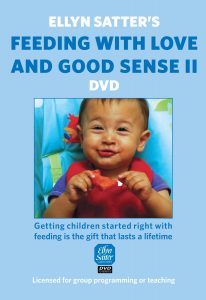

Family Meals Focus
The Ellyn Satter Institute Newsletter
Feeding pressure on all sides
by Ellyn Satter, MS, MSSW, Dietitian and Family Therapist
An estimated half of young children have feeding problems.1 It is little wonder. Research shows that almost all parents of young children are interfering with feeding. They bribe, pressure, and cater, prepare foods their children like, accommodate specific requests, and pacify children with sweets. They don’t believe their children when they say they are full and encourage them to eat more.2
Parents work way too hard
My observations during the making the Feeding with Love and Good Sense II DVD confirms the research. I had the privilege of going into 30 California homes and watching parents feed their children. From that footage, I produced an 80 minute video that shows what to do and not do with feeding. To put a positive spin on it, parents work way too hard! To put a not-so-positive spin on it, parents are interfering. They sit down to a lovely meal and spoil it right away by telling the child, “you know the rules – you have to eat your vegetables.” Often the “eat your vegetables” admonition reverberates, with one parent picking up the words of the other and the first amplifying the second and back again. Parents peer and arrange and wipe-wipe-wipe and scrape together the child’s food. They tap the child’s plate and interrupt her conversation to remind her to finish whatever-it-is. They insist on one bite of everything and reason and praise and feed children who are old enough to feed themselves and explain about nutritional superiority and make bargains about “first this and then that.” They keep up a rat-tat litany: Use your fork, use your spoon, use your napkin. For their part, children do not easily give up their rights with eating. They argue, whine, cry, resist. evade, become defiantly messy, throw anything within reach, and press their parents to make increasingly ridiculous food bargains.
Mealtime interference makes children eat poorly
Children get so much input that they lose touch with themselves: their internal cues of hunger and satiety, their enjoyment and curiosity about food, and their pride in learning to do well with eating.
As a result of all this static, children get so much input that they lose touch with themselves: their internal cues of hunger and satiety, their enjoyment and curiosity about food, and their pride in learning to do well with eating. But parents are stressed as well. They do not enjoy making their child miserable, but they do it anyway because they think it is good parenting with food. Why all the fuss? If children get the support they need – enjoyable family meals – they push themselves along to learn to eat the food their parents eat. Eventually they even do it neatly. Where do parents get the idea that they have to micromanage children’s eating? This pattern is not confined to San Jose, CA, nor is it new. Thirty years ago, an experienced Pediatric Nurse Practitioner observed to me, “If a child eats, parents think it is all their idea.”
Cautious, slow-to-warm-up children do way worse with pressure
Given this pressure on their eating, little wonder that children who are at all cautious and limited with respect to eating develop extreme food selectivity or bizarre food behaviors. If parents follow the Satter Division of Responsibility in Feeding and allow children to move along according to their own tempo, even slow-to-warm-up children learn to enjoy a variety of food. Really cautious kids, such as those with sensory integration disorders and autism spectrum disorders, still push themselves ever-so-slowly along to learn to eat. To do that they need structure, opportunities to learn about all kinds of food and no pressure. Children with neuromuscular limitations struggle to manage the nipple or the spoon and eat until they run out of energy and it stops being enjoyable. Then they need nutritional support delivered in some other way so they and they and their parents don’t have to wear themselves out satisfying their nutritional requirements.
We must teach parents about joyful eating and feeding
The take-home message is that we have work to do. We must let these poor parents – and these poor children – off the hook by teaching parents to follow sDOR and raise children to be Eating Competent. Within a few days or weeks after instituting sDOR, feeding struggles transform into peaceful mealtimes that are enjoyable for both parents and children. Children feel good about their eating, are calm around unfamiliar food, and eat as much as they are hungry for. However, to maintain that serenity parents must give up their agenda that children shall eat certain amounts of certain foods and grow in certain ways. They must be scrupulous about avoiding interference with children’s eating and trust children to eat what and as much as is right for them.
References
- Sherry B, McDivitt J, Birch L, et al. Attitudes, practices, and concerns about child feeding and child weight status among socioeconomically diverse white, Hispanic, and African-American mothers. J Am Diet Assoc. 2004;104:215-221.
- Linscheid TR, Budd KS, Rasnake LK. Pediatric feeding problems. In: Roberts MC, ed. Handbook of Pediatric Psychology (3rd ed). New York, New York: Guilford; 2003:481-498.
Explore
To let yourself off the hook with getting your child to eat, read Ellyn Satter’s Child of Mine: Feeding with Love and Good Sense.
To see the Santa Clara County parents in their homes, succeeding or struggling with feeding their children, see Ellyn Satter’s Feeding with Love and Good Sense DVD II.For the home use version, click here.

More about not being interfering with feeding
- Follow Satter’s Division of Responsibility in Feeding (sDOR)
- Avoid pressure
- Avoid restriction
- Children know how much they need to eat
- Family-friendly feeding tips
- How children become competent eaters
- How children learn to eat new food
- How to become eating competent
Related issues of Family Meals Focus
- Adoptive and foster child feeding problems
- Does the division of responsibility in feeding work in clinical care?
- Feeding neglected children mandates division of responsibility in feeding
- Food restriction in disguise
- The division of responsibility in feeding works for special needs
- Picky eating: Born or made?

